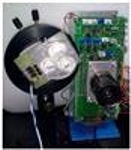May 12 2010
Fondazione Bruno Kessler (FBK) researchers have developed a 3D digital camera. Likely applications of this camera include videogames, virtual reality, surveillance and security and elderly homes’ monitoring. A patented prototype of this camera will be presented during the European project Netcarity conference in Eindhoven, the Netherlands.
FBK’s Integrated Optical Sensors (SOI) Research division’s David Stoppa and his team had designed the camera. The camera’s new technology also marks a significant milestone for Italian research as the physical dimensions of the camera’s reading cells’ has the smallest pixels (10 ìm) available in this field, which is the equivalent to one tenth of a human hair’s size. As a result of this, the cell enables the prototype camera the capacity to capture images with the maximum possible details.
 FBK Preliminary prototype of the 3D vision system developed by SOI FBK researchers
FBK Preliminary prototype of the 3D vision system developed by SOI FBK researchers
Lorenzo Gonzo was the leader of the SOI research team. The team received the European Union’s financial support for developing the prototype for the Netcarity project that is dedicated to developing new technologies to enhance home living.
The new camera of FBK recovers third dimension projections while existing digital cameras only offer 2D projections of a scene shot. The camera uses ultra short laser pulses of light to illuminate the scene and these light pulses reflected by the target shot is then detected by a metal oxide semiconductor (CMOS) micro-sensor in the camera in order to compute various objects’ distances thereby providing a third dimension image. This camera in an essence duplicates the stereoscopic vision of human beings, who are able to view targets in their field of sight in 3D.
The FBK research team is among the first to have developed a sensor of this type utilizing standardized CMOS technology that is also utilized for producing microprocessors and many electronic components and ensures production cost savings.
The sensor can also be used to provide help and ensure security of the disabled and the elderly. The 3D scene perception enables detection of danger situations reliably like accidental falls and helps to lower the risks for those who live without assistance or help. The 3D camera can also be utilized for interaction solutions and intelligent navigation to be utilized as sophisticated electronic guides in museums. The 3D vision camera can also be used in next generation videogames for reading the movements of players directly. Players would be able to simulate a game or sports challenge without having to wear or hold a gadget that conveys the movement of players to a computer.